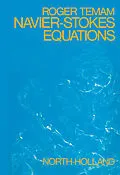Navier-Stokes Equations: Theory and Numerical Analysis focuses on the processes, methodologies, principles, and approaches involved in Navier-Stokes equations, computational fluid dynamics (CFD), and mathematical analysis to which CFD is grounded. The publication first takes a look at steady-state Stokes equations and steady-state Navier-Stokes equations. Topics include bifurcation theory and non-uniqueness results, discrete inequalities and compactness theorems, existence and uniqueness theorems, discretization of Stokes equations, existence and uniqueness for the Stokes equations, and function spaces. The text then examines the evolution of Navier-Stokes equations, including linear case, compactness theorems, alternate proof of existence by semi-discretization, and discretization of the Navier-Stokes equations. The book ponders on the approximation of the Navier-Stokes equations by the projection and compressibility methods; properties of the curl operator and application to the steady-state Navier-Stokes equations; and implementation of non-conforming linear finite elements. The publication is a valuable reference for researchers interested in the theory and numerical analysis of Navier-Stokes equations.
Klappentext
Navier-Stokes Equations: Theory and Numerical Analysis focuses on the processes, methodologies, principles, and approaches involved in Navier-Stokes equations, computational fluid dynamics (CFD), and mathematical analysis to which CFD is grounded.
The publication first takes a look at steady-state Stokes equations and steady-state Navier-Stokes equations. Topics include bifurcation theory and non-uniqueness results, discrete inequalities and compactness theorems, existence and uniqueness theorems, discretization of Stokes equations, existence and uniqueness for the Stokes equations, and function spaces. The text then examines the evolution of Navier-Stokes equations, including linear case, compactness theorems, alternate proof of existence by semi-discretization, and discretization of the Navier-Stokes equations. The book ponders on the approximation of the Navier-Stokes equations by the projection and compressibility methods; properties of the curl operator and application to the steady-state Navier-Stokes equations; and implementation of non-conforming linear finite elements.
The publication is a valuable reference for researchers interested in the theory and numerical analysis of Navier-Stokes equations.
Inhalt
Foreword
Preface to the Third (Revised) Edition
Chapter I. The Steady-State Stokes Equations
Introduction
Some Function Spaces
1.1 Notation
1.2 A Density Theorem
1.3 A Trace Theorem
1.4 Characterization of the Spaces H and V
Existence and Uniqueness for the Stokes Equations
2.1 Variational Formulation of the Problem
2.2 The Projection Theorem
2.3 The Unbounded Case
2.4 The Non-Homogeneous Stokes Problem
2.5 Regularity Results
2.6 Eigenfunctions of the Stokes Problem
Discretization of the Stokes Equations (I)
3.1 Approximation of a Normed Space
3.2 A General Convergence Theorem
3.3 Approximation by Finite Differences
Discretization of the Stokes Equations (II)
4.1 Preliminary Results
4.2 Finite Elements of Degree 2 (n = 2)
4.3 Finite Elements of Degree 3 (n = 3)
4.4 An Internal Approximation of V
4.5 Nonconforming Finite Elements
Numerical Algorithms
5.1 Uzawa Algorithm
5.2 Arrow-Hurwicz Algorithm
5.3 Discrete Form of these Algorithms
The Penalty Method
6.1 Convergence of ue to u
6.2 Asymptotic Expansion of ue
6.3 Numerical Algorithms
Chapter II. The Steady-State Navier-Stokes Equations
Introduction
1. Existence and Uniqueness Theorems
1.1 Sobolev Inequalities and Compactness Theorems
1.2 The Homogeneous Navier-Stokes Equations
1.3 The Homogeneous Navier-Stokes Equations (Continued)
1.4 The Non-Homogeneous Navier-Stokes Equations
Discrete Inequalities and Compactness Theorems
2.1 Discrete Sobolev Inequalities
2.2 A Discrete Compactness Theorem for Step Functions
2.3 Discrete Sobolev Inequalities for Non Conforming Finite Elements
2.4 A Discrete Compactness Theorem for Non Conforming Finite Elements
Approximation of the Stationary Navier-Stokes Equations
3.1 A General Convergence Theorem
3.2 Applications
3.3 Numerical Algorithms
Bifurcation Theory and Non-Uniqueness Results
4.1 The Taylor Problem. Preliminary Results
4.2 A Spectral Property of B
4.3 Elements of the Topological Degree Theory
4.4 The Non Uniqueness Theorem
Chapter III. The Evolution Navier-Stokes Equations
Introduction
The Linear Case
1.1 Notations
1.2 The Existence and Uniqueness Theorem
1.3 Proof of the Existence in Theorem 1.1
1.4 Proof of the Continuity and Uniqueness
1.5 Miscellaneous Remarks
Compactness Theorems
2.1 A Preliminary Result
2.2 A Compactness Theorem in Banach Spaces
2.3 A compactness Theorem Involving Fractional Derivatives
Existence and Uniqueness Theorems (n = 4).
3.1 An Existence Theorem in Rn (n = 4)
3.2 Proof of Theorem 3.1
3.3 Regularity and Uniqueness (n = 2)
3.4 About Regularity and Uniqueness (n = 3)
3.5 More Regular Solutions
3.6 Relations Between the Problems of Existence and Uniqueness (n = 3)
3.7 Utilization of a Special Basis
3.8 The Special Case f = 0
Alternate Proof of Existence by Semi-Discretization
4.1 Statement of the Problem
4.2 The Approximate Solutions
4.3 A Priori Estimates
4.4 Passage to the Limit
Discretization of the Navier-Stokes Equations: General Stability and Convergence Theorems
5.1 Description of the Approximation Schemes
5.2 Stability of the Schemes 5.1 and 5.2
5.3 Stability of Scheme 5.3
5.4 Stability of Scheme 5.4
5.5 A Complementary Estimate for Scheme 5.2
5.6 Other a Priori Estimates
5.7 Convergence of the Numerical Schemes
Discretization of the Navier-Stokes Equations: Application of the General Results
6.1 Finite Differences (APX1)
6.2 Finite Elements (APX2), (APX3), (APX4)
6.3 Non Conforming Finite Elements (APX5)
6.4 Numerical Algorithms. Approximation of the Pressure
Approximation of the Navier-Stokes Equations by the Projection Method
7.1 A Scheme with Two Intermediate Steps
7.2 A Scheme with n + 1 Intermediate Steps
7.3 Convergence of the Scheme
Approximation of the Navier-Stokes Equations by the Artificial Compressibility Method
8.1 Study of the Perturbed Problems
8.2 Convergence of the Perturbed Problems to the Navier-Stokes Equations
8.3 Approximation of the Perturbed Problems
Appendix I Properties of the Curl Operator and Application to the Steady State Navier-Stokes Equations
Appendix II Implementation of Non-Conforming Linear Finite Elements
Comments
Additional Comments to the Re…
